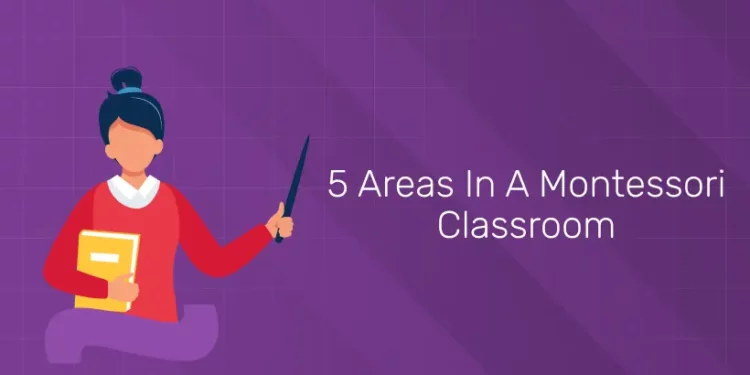Montessori classrooms are organized and well-thought-out. While many aspects of the Montessori curriculum are comparable to those of standard early learning programs, the five areas of unique learning materials and procedures are how Montessori differentiates itself from other educational institutions. You’re in the right place if you’ve been wondering what the five areas of montessori class room are ! In this article we are discussing about the five important areas in a montessori classroom.
Unlock your passion for education and shape young minds as a Montessori teacher!
Five Areas In A Montessori Classroom
The five areas of montessori classroom are:
- Practical Life
- Sensory Education
- Language
- Mathematics
- Science and Culture
Practical Life
Through teaching children how to interact with their surroundings, Montessori practical life exercises aim to prepare your child for everyday life. These exercises are designed to look like real-world activities since they make use of functioning yet breakable items. The basis for all other Montessori learning activities is laid by this field of study, which teaches independence, coordination, focus, self-control, self-awareness, and confidence. It is one of the important areas of a montessori class room.
Exercises for a practical life include taking care of oneself and the environment, like:
- Preparing food and dressing
- Hand hygiene
- Honed motions
- Silently moving
- Keeping Gardens Clean
- Taking care of animals
- Conduct
- Social exchanges etc.
Significance Of Practical Life education
- Independence
- Concentration
- Order and prganization
- Fine motor skills
Sensory Education
It is another important area in a montessori class room. The sensory education train the kid to hone their skills in reading, writing, and math through the use of their five senses. For instance, a youngster who has learned to distinguish between minute variations in sound cylinders is more likely to pick up on small variations in letter phonetic sounds. A youngster can develop control over the small finger muscles he will use for writing by holding tiny knobs on equipment. All intellectual faculties are developed when the senses are used to investigate the many materials created with changing dimension, color, form, texture, and smell.
Exercises for a sensory education includes:
- Visual perception
- Feel (kinesthetic)
- Odor (perceptual)
- Gustatory taste
- Audio (sound)
- Kinaesthetic (stereognostic)
Significance Of Sensory Education
- Critical Thinking
- Sensory Development
- Preparation for Academic learning
Language Development
Oral language development is the starting point for Montessori language activities, which then move on to reading and writing. Via dialogue, narrative, and vocabulary-building exercises, children are exposed to a variety of rich language experiences. In order to improve phonemic awareness, letter recognition, and early reading abilities, they also interact with things including movable alphabets, phonetic objects, and sandpaper letters. Students trace, write, and ultimately create their own words and stories as part of writing exercises. The purpose of the Montessori language resources is to offer a methodical and experiential approach to the development of literacy.
Significance Of Language Development
- Communication skill
- Literacy development
- Cognitive development
Start Your Journey To become A Certified Montessori Teacher! Get Free Demo Here!
Mathematics Exploration
In this area of montessori classroom, children are taught to abstract mathematical concepts using concrete, hands-on materials. Among these supplies are sandpaper numerals, beads, counters, number rods, and other mathematical manipulatives. Children explore a range of subjects, such as place value, fractions, geometry, numbers, addition, subtraction, multiplication, and division. The materials are carefully curated and designed to give children a practical introduction to mathematical concepts before moving on to more abstract representations, assisting in the development of a comprehensive understanding of mathematical principles.
Mathematic excercise includes:
- Number rods
- Sandpaper numbers
- Number boards
- Spindle box
- Number tiles
- Beads
- Games etc.
Significance Of Mathenatics Exploration
- Problem solving skills
- Concrete understanding
- Numeracy
Science And Culture
Children in this area of montessori classroom receive introductions to the natural world, geography, history, science, and a diversity of cultural practices. Products such as maps, globes, puzzles, artifacts, books, and experiments can encourage investigation, discovery, and questioning. Children learn about different cultures, ecosystems, scientific ideas, and how all living things are interdependent.
Science and Cultural exercises cover a wide range of subjects, including:
- Geography
- Zoology
- Science
- Botany
- History
- Art
- Music etc..
Significance Of Cultural Studies And Science
- Environmental consiousness
- Global awareness
- Critical inquiry
CONCLUSION
A Montessori classroom offers a dynamic and stimulating environment that enables children to study and grow according to their own interests and abilities at their own pace. Each area has been carefully designed to support a child’s overall development. Every subject has been carefully chosen to include materials and activities that support independence, concentration, coordination, creativity, critical thinking, and a strong love of learning.
Unlock Your Passion For Education And Shape Young Minds As A Montessori Teacher!











